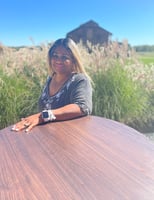Do you know the difference between harmless snakes and venomous snakes?
I don't know about your kids, but my kids LOVE snakes! We used to live in California (don't hate me, lol!) and when we would go camping, my son would catch a snake every time without fail. It was easy for me to let him catch snakes out there, because the only venomous snakes we had were rattlesnakes, and they are pretty easy to identify. The whole game changed when we moved to Alvarado, Texas though. There are quite a few more venomous snakes here, and they aren't as easily identifiable (they don't all have warning rattles out here!) so I started learning as much as I could about the different kinds of snakes and teaching my children about them, too. A great resource I found shortly after moving here was the What Kind of Snake is This? Facebook Group. In this group, you can post pictures of snakes you come across and an actual expert will help you identify them. I had the pleasure of being able to interview one of the admins for that group, Josh Leblo, and he shared his snake-y knowledge with us. Here is what he had to say:
First, can you please tell me a little bit about yourself and what you do that led you to become an admin of the snake group? How did you learn so much about snakes?
I started learning about snakes because at my work we would frequently have snakes come up to the building. I didn't want to see the snakes killed so I started relocating them, but didn't have any idea how to identify them and that led me to the What snake is this? North Texas page. My slight fear turned into fascination as I slowly learned how to identify or local venomous snakes and then that led to me learning the other native snakes in the area. After several years of helping identify and answer questions about snakes, I was asked to join the admin team.
And now to the snake questions:
1) What are the types of venomous snakes in North Texas? In what we consider North Texas, there are 8 different venomous snakes. They can be broken down into 4 categories, Cottonmouth, Copperheads, Rattlesnakes, and Coral snake. (Click here to download the graphic)
2) Is there an easy way to tell if a snake is venomous just by looking at it? Unfortunately, there isn't an easy one-step solution that will help to identify venomous snakes. My recommendations are to learn the venomous snakes in your area and what they look like, and while you are learning these to take a picture of snakes you encounter and post them on the What snake is it? Facebook page. We generally can accurately identify snakes in less than 30 seconds.
3) What should a person do if they encounter a venomous snake? Back away. The only time a venomous snake is dangerous is when it feels threatened and by backing away you alleviate that threat. Most snake bites occur when trying to kill a snake or handling a snake.
4) How are snakes beneficial to the environment? They are part of our natural habitat life cycle. They control the rodent populations as well as water ecosystems.

5) Are there areas where a person is more likely to encounter a snake? As is the case for most wildlife, remote undisturbed areas will always be the highest population. Around your house areas of concern would be wood and brush piles, or any place that they can hide from predators such as under sheds and other debris.
6) What should someone do if they get bitten by a snake? Step one is to not panic and back away. You do not need to catch the snake, but a picture could help others identify it to advise further action. This article by Spencer Greene is one of the best I have seen on the subject. There is also a Facebook group run by medical professionals specifically for snakebite advice.
7) What is your favorite kind of snake? Natively, my favorite snakes are the Broad-banded watersnake (I call them the snake on fire) and the Eastern Hognose snake.
8) Besides for the FB group, are there any other resources you recommend to learn more about snakes? Texassnakeid.com and I got a Peterson's Field guide for reptiles and amphibians from the East coast as well.
9) Is there any more information that you would like to add? We have been taught from when we are little to be afraid of snakes, but I believe that this fear comes from a lack of understanding of the purpose and benefit that snakes provide.
I know snakes can be scary, but remember that they are more afraid of you, and usually will only bite when threatened. I hope this article was informative and helped to take a little of the mystery out of snakes and made them more likable.
Remember though, it is always a good idea to leave the snakes alone and NOT pick them up unless you are 100% certain that they are harmless!
And go join the What Snake is This Facebook group for more helpful snake information.
Pin this image so others can find this article:



